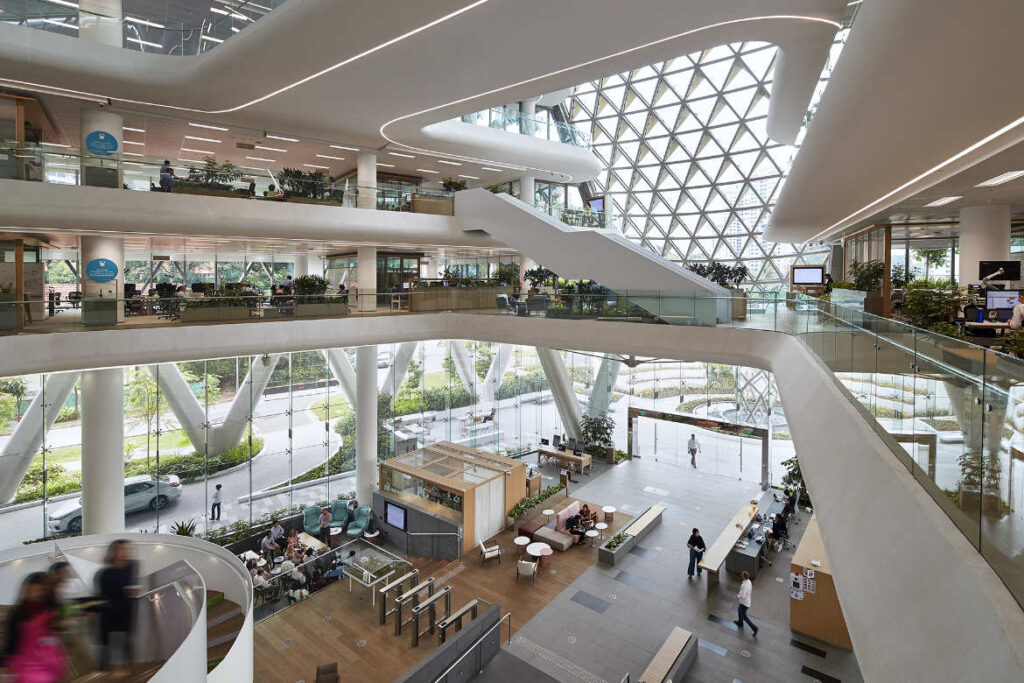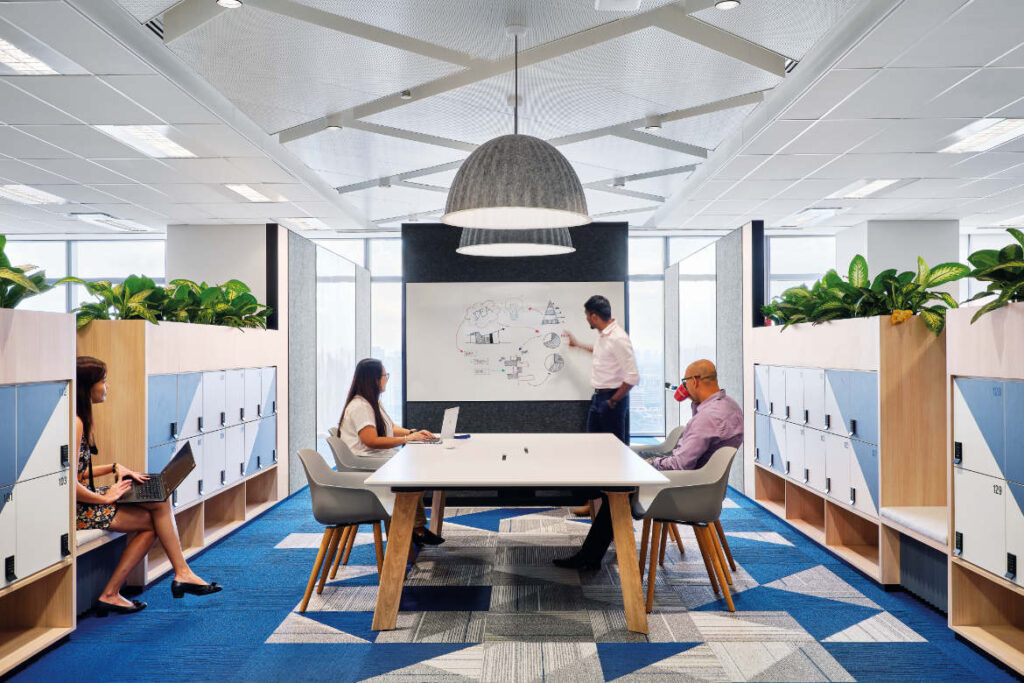The pandemic-driven disruption of how we work has been painful for both companies and employees. But it is also providing an opportunity for everyone to recalibrate how we want the future of work to look like.

Pockets of collaboration spaces in open work settings pepper the Total office by Geyer and were designed to promote interaction and co-creation. Photo by Owen Raggett.
February 28th, 2022
If the idea of bosses holing themselves up in their prized corner office while employees stay glued to their desks nine hours a day did not seem archaic to employers pre-COVID-19, it certainly should now.
In one fell swoop, the pandemic has not only hurled new challenges at companies, but also magnified what was already found wanting in organisations and the workplace; ideas around culture, flexibility and optimisation have all been brought to question.
Despite the significant increase in agile workspaces in Singapore since the early 2010s with multi-national companies setting up regional headquarters and importing progressive global work practices and policies, many workplaces here had not yet adapted to the new era of working.

“Many workplaces were systemically broken well before COVID-19 hit. There was a high level of disengagement, and there was so much disruption in the way people were learning, and seeking out social capital. Social media had entered the workplace, influencing how we feel, think and act as individuals. Employees are more concerned these days about what their organisations stand for,” says Tamagin Blake-Smith, principal at HASSELL. He’s calling the current situation we’re in “the greatest reset in history”.
“Habits are changing and our perception of what is productive is changing,” says Dr Caroline Burns, founder and managing director of workplace transformation consultancy Workplace Revolution. “These shifts will start to inform how the office should evolve to support the way people want to work.”
Inevitably, hygiene and safety are key in the current situation and companies need to look into providing safe environments for their staff. Equally important is the psychological safety it brings, which also addresses anxieties people may have about returning to the office. “The level of anxiety may come down faster in Singapore and other places where there’s more trust [in the authorities] and where there’s a sense that the problems brought about by the pandemic can be solved if everyone comes together,” says Burns.
Equally important to address, especially in the mid- to long-term evolution of organisations, are deep-seated cultural issues that have largely managed to evade scrutiny and action on a broad scale thus far.

In particular, the amplified conversation around flexible working arrangements, triggered by the government-imposed work-from-home mandate in Singapore, has been a game-changer across multiple sectors. In tandem with this is the newfound agility in workplaces that has resulted from the most rapid digital transformation in history.
If implementing flexible working policies was previously a strategy to retain a younger pool of talent who increasingly value work-life balance, the stakes just got higher with the majority of employees in Singapore having now tasted the benefits of increased flexibility and more time with their families – while still maintaining a certain level of productivity in their work.
In a survey of 20,000 respondents from 127 companies conducted by EngageRocket in partnership with the Singapore Human Resources Institute and the Institute for Human Resource Professionals, over two-thirds of respondents across industries indicated that they would prefer to work from home 50 to 70 per cent of the time.1
The implications on the workplace arising from the normalisation of flexible working arrangements are multi-faceted and at times competing, ranging from considerations such as office footprint and efficiencies to how workspaces should evolve to support a healthy and dynamic work culture.
“The workplace becomes more a place for community,” says Joanne Morris, studio leader at Geyer. “It needs to be designed for collaboration, innovation and social connectedness with wellness in mind.”

As leadership styles evolve towards having greater empathy for employees and an openness to a more human-centric approach to work, there is a higher possibility that strategies around wellness, diversity, inclusion and learning, while not unfamiliar, could feature more prominently in conversations about work culture and the spaces that facilitate it.
“Creating opportunities to align development of talent, collaboration and innovation within the workplace brings more diversity in the way people learn and gives purpose and reason for us to be together and connected physically,” Blake-Smith shares.
HASSELL’s campus-like design of GSK’s (GlaxoSmithKline) Asia Headquarters was conceptualised from the inside-out to provide such opportunities. The open, multi-layered and completely reconfigurable environment was tailored to encourage connectivity, cross-functional collaboration and agility. Similarly, Arup’s Singapore office, also designed by HASSELL, champions the same collaborative approach in its design and is supported by strong technological and social systems.

“We think [day-to-day operational] activities could start to reduce in the workplace. Instead, people would look for spaces with deeper, more immersive experiences,” Morris says, introducing the idea of the experience-based workplace (EBW).
For Geyer, the EBW approach has proven successful with projects such as the Total and HSBC offices in Singapore, and the Carpe Diem Community workplace in Australia. In these projects, consideration for various personality types (introverts and extroverts, for example) and a focus on community and wellness result in a diverse offering of environments running the gamut from active communal and collaborative spaces to quiet, focussed areas for mindfulness and calm. “Having flexible working is also encouraging companies to provide the same amenities and experiences in the office that people have at home,” says Morris.

Understandably, foremost on the minds of organisations today is the need to cut costs. This, coupled with a smaller proportion of employees being in the office on a day-to-day basis, points to a future where office footprints are reduced in favour of more distributed workspace arrangements. Government-initiated business parks with shared facilities and co-working spaces provide possible ways forward in creating hybrid workspace portfolios that also accommodate the call for more human-centric spaces.
In particular, Blake-Smith calls out the role that co-working spaces could play in the greater scheme of things: “They give corporates greater flexibility rather than entering into long-term leases. We’re also going to see a greater incubation of SMEs (small-medium enterprises) in co-working spaces – they want to get out of terrible buildings but can’t afford to build them themselves. The co-working space is a way for SMEs to look after their employees better.”
Despite how the original value proposition of co-working spaces has generally been diluted, he points to the unique opportunities they provide that should be mined: “Co-working is not just a space solution. It’s about creating communities.” He shares that this had formed the premise for HASSELL’s design of The Great Room at Raffles Hotel.
Jaelle Ang, CEO and Co-founder of The Great Room says, “Nothing replaces the energetic and exponential burst of ideas during an in-person ideation session or getting the ‘missing piece of information’ from a serendipitous chat. Workspaces can be much more than fitting more headcount per square foot, but a modern agora of learning and a social network.”

As it stands, the quest to get the best performance out of the least number of people in the smallest workplace possible continues. It is expected as organisations do everything they can to survive during this economic crisis. But as things recover over time, how can companies future-proof themselves and their workspaces against another crisis? In this respect, Burns offers one alternative to the meticulously optimised workspace: “Our pursuit of efficiency is noble and has lots of benefits. But there is a massive trade-off – the more you pursue efficiency, the less you are able to pursue what I call ‘wiggle-room’.”
“While organisations are providing more alternative and choice spaces, general overall footprint and cost-per-person has been shrinking, and maybe we’ve reached a tipping point where it’s shrunk enough. So, for example, rather than drive space-per-person down to 60sqft, maybe 65sqft gives you that little bit of wiggle-room.”
The idea of providing a bit more space to accommodate the possibility of switching up configurations and usage comes with inevitable costs and redundancies of course. Not to mention, it goes against Singapore’s notorious penchant for efficiency. But, according to Burns, it is one way to give companies the agility to respond to changes. For now, the crisis has provided the best opportunity in decades for organisations to stress test their ability to respond to change – a critical capability for survival in the digital age.
The multiple challenges and considerations that companies now have to contend with are immense. And while the only sensible approach to take now is a measured and empathic one with everything still in flux, there can be no delaying an in-depth rethink about how we want to work in the days ahead.
Related: How the pandemic worked in favour of coworking spaces
A searchable and comprehensive guide for specifying leading products and their suppliers
Keep up to date with the latest and greatest from our industry BFF's!

XTRA celebrates the distinctive and unexpected work of Magis in their Singapore showroom.

Elevate any space with statement lighting to illuminate and inspire.

Within the intimate confines of compact living, where space is at a premium, efficiency is critical and dining out often trumps home cooking, Gaggenau’s 400 Series Culinary Drawer proves that limited space can, in fact, unlock unlimited culinary possibilities.

In this New Zealand workplace design by Wingates, Anthony Harper were “keen to evolve their working environment as the world evolves as well.”

The global leader in design and innovation, formed from the merger of Herman Miller and Knoll, recently hosted an exclusive event to mark a milestone in its partnership with Pergo.
The internet never sleeps! Here's the stuff you might have missed

Led by Kart Projects and brought to life within an existing warehouse space, the new HQ for Studio Mass needed creativity, flexibility and a nuanced interplay between both digital and physical places of connection.

GEYER VALMONT recently threw a party celebrating the official launch of their unified brand, 20 years of Valmont and the opening of a new home in the heart of Sydney CBD.